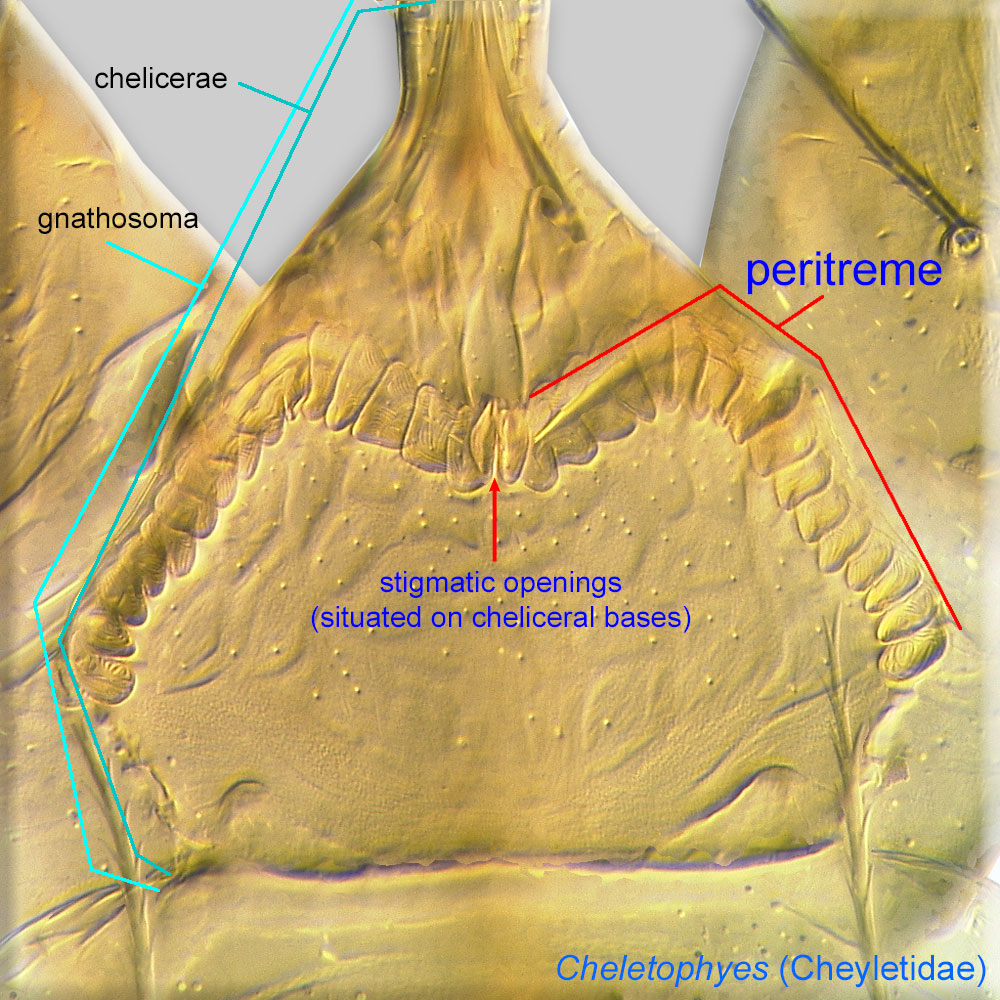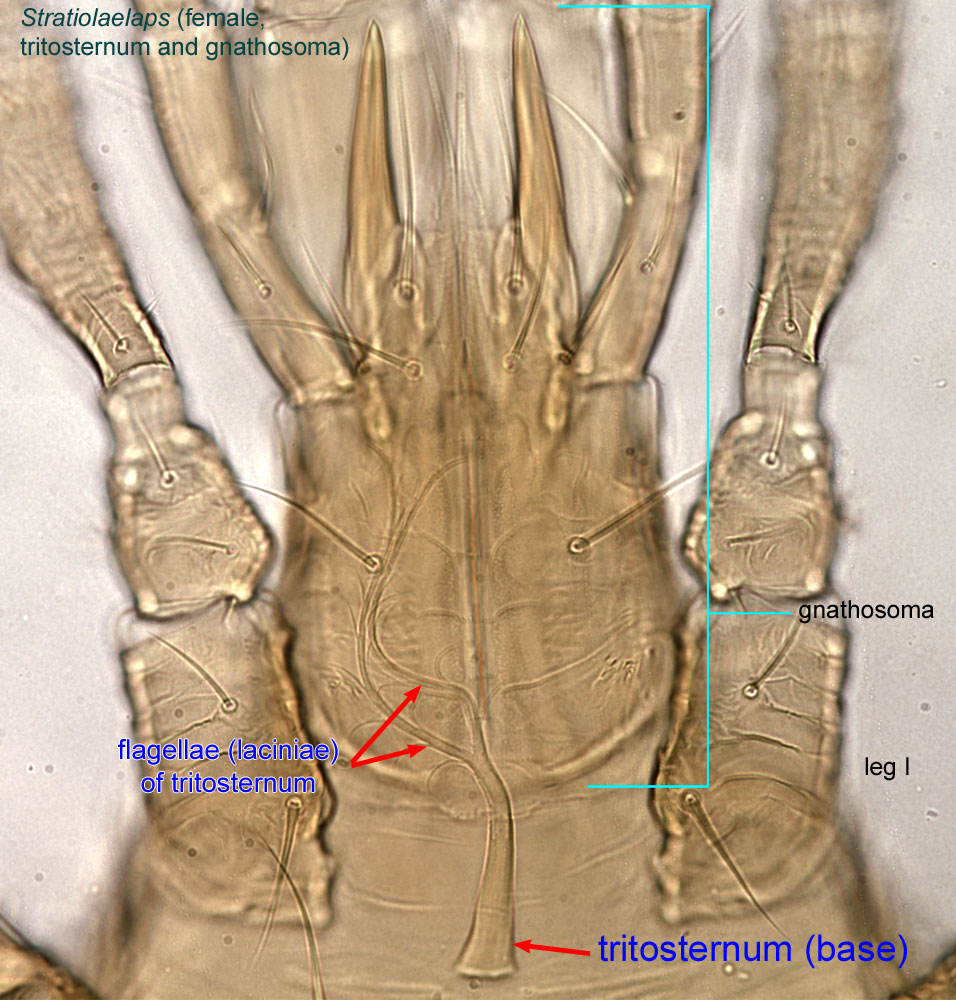probably kleptoparasitic; feeds on pollen and nectar in bee nests
Xylocolaelaps
Superorder Parasitiformes » Order Mesostigmata » Suborder Monogynaspida » Hyporder Dermanyssiae » Family Laelapidae » Genus Xylocolaelaps
Xylocolaelaps burgetti Royce and Krantz, 2003Royce and Krantz, 2003:
Royce, L. A. amp; G. W. Krantz. 2003. A new genus and species of hypoaspidine mite (Acari : Laelapidae) associated with a night-flying xylocopinine carpenter bee (Hymenoptera : Apidae : Xylocopa) in Thailand. International Journal of Acarology. 29:107-111.
Female: PeritremesPeritreme:
Paired, tubular, elaborated extensions of a tracheal system associated with stigmatic openings. Can be chambered, arch-like, and situated on the bases of chelicerae as in Cheyletidae (Prostigmata) or, in Mesostigmata, linear and situated on the lateral sides of the body.
 typical, extending anteriorly beyond legs II (Figs. 1, 2). Sternal setae st3 situated on sternal shieldsternal shield:
typical, extending anteriorly beyond legs II (Figs. 1, 2). Sternal setae st3 situated on sternal shieldsternal shield:
A shield in the anterior intercoxal region of parasitiform mites that bears one or more pairs of sternal setae.
 (Figs. 1, 3). Stigmata not enlarged: width of stigmatic field subequal to base of tritosternumtritosternum:
(Figs. 1, 3). Stigmata not enlarged: width of stigmatic field subequal to base of tritosternumtritosternum:
In Mesostigmata, a biflagellate structure situated on the ventral side of the body, posterior to the gnathosoma and anterior to the sternal shield. Sometimes the flagellae (laciniae) are partially or completely fused.  (Fig. 2). Unpaired setae on posterior opisthosomaopisthosoma:
(Fig. 2). Unpaired setae on posterior opisthosomaopisthosoma:
Body division posterior to legs IV; usually there is no distinct boundary delimiting this part of idiosoma.
absent, as in type species, or present.
This genus includes a single described species, Xylocolaelaps burgetti. In addition, at least one undescribed species is known (our data).
Pneumolaelaps. Xylocolaelaps can be distinguished from Pneumolaelaps by its sternal setae st3 not extending (Fig. 3) or slightly extending beyond bases of setae st4 as in Xylocolaelaps burgetti; in Pneumolaelaps, st3 are longer and distinctly extend beyond bases of st4. Peritrematic shields do not extend beyond stigmata posteriorly in Xylocolaelaps (Fig. 2), while in Pneumolaelaps these shields extend beyond stigmata.
Stigmatolaelaps. Xylocolaelaps can be distinguished from Stigmatolaelaps by stigmatic fields not being enlarged (enlarged in Stigmatolaelaps).
Oriental and African regions.
large carpenter bees (Xylocopa)
permanentpermanent:
associated exclusively with bees or their close relative, wasps; cannot live without these hosts
These mites are probably kleptoparasitic, feeding on pollen and nectar stored in the nest of its carpenter bee host as food for the larvae. In X. burgetti adult females are probably phoreticphoretic:
Pertaining to phoresy; using another organism (i.e., a host) for dispersal to new habitats. Phoresy can be distinguished from parasitism because feeding typically does not occur during phoresy.
on female bee hosts. The lack of observation of phoreticphoretic:
Pertaining to phoresy; using another organism (i.e., a host) for dispersal to new habitats. Phoresy can be distinguished from parasitism because feeding typically does not occur during phoresy.
females may be attributed to the fact that phoresyphoresy:
Attaching to or boarding another organism (i.e., a host) for dispersal to new habitats. Can be distinguished from parasitism because feeding typically does not occur.
may be relatively rare because in the mite's host, Xylocopa tranquebarica, daughters of founding bees share the nest with their mothers for an extended period of time (Royce and Krantz, 2003Royce and Krantz, 2003:
Royce, L. A. amp; G. W. Krantz. 2003. A new genus and species of hypoaspidine mite (Acari : Laelapidae) associated with a night-flying xylocopinine carpenter bee (Hymenoptera : Apidae : Xylocopa) in Thailand. International Journal of Acarology. 29:107-111.). This trait of natural history of the host bee eliminates the need for frequent mite dispersal. We found an undescribed species of Xylocolaelaps phoretic phoretic:
Pertaining to phoresy; using another organism (i.e., a host) for dispersal to new habitats. Phoresy can be distinguished from parasitism because feeding typically does not occur during phoresy.
on Xylocopa nigrita in Africa, confirming the original hypothesis (Royce and Krantz, 2003Royce and Krantz, 2003:
Royce, L. A. amp; G. W. Krantz. 2003. A new genus and species of hypoaspidine mite (Acari : Laelapidae) associated with a night-flying xylocopinine carpenter bee (Hymenoptera : Apidae : Xylocopa) in Thailand. International Journal of Acarology. 29:107-111.) of female phoresyphoresy:
Attaching to or boarding another organism (i.e., a host) for dispersal to new habitats. Can be distinguished from parasitism because feeding typically does not occur.
in this genus.